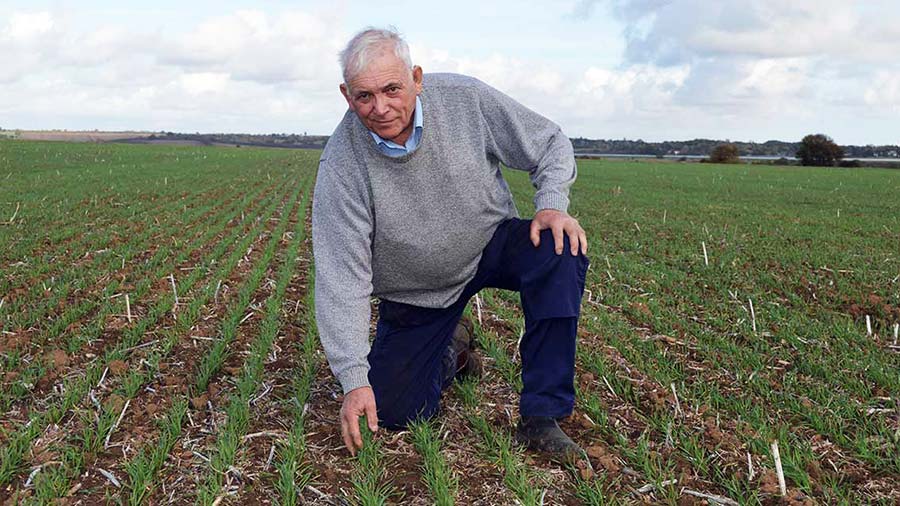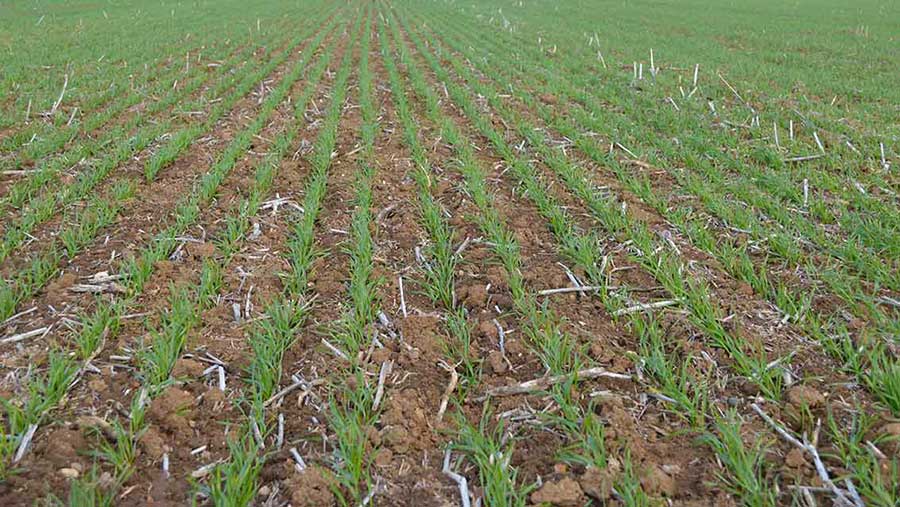Grower returns to milling wheat with low fertiliser needs
 © MAG/David Jones
© MAG/David Jones Essex wheat grower Phil Cottis is renewing his interest in the often-forgotten milling variety Illustrious, as it looks to be an efficient user of nitrogen to produce high-protein grain and may help save him some expensive nitrogenous fertiliser.
A small 2.8ha area of the winter wheat variety produced a 14% protein grain sample this summer at a respectable yield of 9t/ha, slightly ahead of the farm’s average.
So he has drilled 65ha this autumn with an increased seed rate to compensate for its shy tillering habit.
See also: Essex wheat grower earns extra premium by hitting 14% protein
He is growing 400ha of milling wheat using all the four main varieties – Skyfall, Zyatt, Crusoe and Illustrious – with the vast majority of his grain hitting breadmakers’ specification for 13% protein grain.
He is now looking to see if the latter variety might enable him cut fertiliser costs.
“Illustrious looks to have good potential for us to reduce nitrogen as it shows good utilisation of nitrogen like the old variety Hereward,” he tells Farmers Weekly.
Poor tillering
This season he has increased his seed rate by nearly 10%.
He will look to apply a higher first dose of nitrogen fertiliser early in the spring to overcome its shy tillering habit and tendency to lose tillers through the winter and early spring.
He farms, with his son Richard, some 600ha of combinable crops on heavy clay soils at Lambourne Hall, Canewdon, just north of Southend.
Two-thirds of the farm grows milling wheat and the other third break crops, such as oilseed rape along with spring and winter beans.
The Essex coast sees an annual rainfall of below 500mm, one of the driest areas of Britain and so it is difficult to produce massive yields of barn-filling Group 4 feed wheats.
This means the focus is hitting milling premiums in milling-quality wheats and this summer, in a harvest of generally low proteins, virtually all the wheat met the miller’s needs.
Phil has a six-year rotation of two wheats followed by oilseed rape, a two further wheats and then beans, with spring oats filling in as a break crop if there is a problem drilling rapeseed or beans.
Variety choice
Among his varieties, Crusoe does well as a first wheat, Zyatt as a second and Skyfall in both positions.
He was looking for a replacement for the old favourite Hereward, which had been grown on the farm for 30 years, but its yield was beginning to falter and the last crop was harvested in 2021.
He had tried Illustrious five years ago but its yield was not impressive and so was dropped.
However, he was tempted to try again as Skyfall and Zyatt had to be fed with a lot of nitrogen to produce high proteins, and with nitrogen fertiliser rocketing in price, it was hoped Illustrious could be grown with less nitrogen.
Last season’s crop was drilled on 10 October following peas, with a three-way split of ammonium nitrate totalling 264kg/ha, in 90-110-64 doses, and then a late liquid Profol 18% dose giving an extra 35kg/ha applied at the ear cheesy ripe stage.
That 2.8ha block produced the 9t/ha yield at 14% protein, a Hagberg of 354 and specific weight of 80.4kg/hl and was snapped up by a local miller.
The protein was higher than Skyfall and Zyatt, with only some of the former hitting 14% and Zyatt generally about 13%. Crusoe stood up well and produced 14% grain.

© MAG/David Jones
Increased area
This season’s 65ha crop was drilled on 3-5 October following spring beans, after land preparation consisted of a combination of disc harrow, press, spraying off with glyphosate, then rolled and sown with a Horsch Avatar disc drill.
This autumn the seed rate was increased to 202kg/ha compared with normal farm practice of 185-192kg/ha on some high moisture-retentive London clay soils and Mr Cottis says the crop looked “fantastic” in late October.
Next spring he will look to increase the early first nitrogen dose to 100kg/ha from 90kg/ha in late February, to encourage tillering and limit tiller losses.
“We don’t want to see the crop stressed, turning yellow and losing tillers,” he says.
However, with the sharp rise in nitrogen fertiliser prices, he is looking to cut back overall nitrogen levels across his wheat by 20kg/ha and hopes it will not have a big effect on the grain protein.
Disease risk
On the disease front, rusts tend to be a bigger threat on the dry east coast than the wet weather-loving septoria, and he says yellow rust can come in early in the season and brown rust is a threat in late May onwards.
He has a three-spray T1-T2-T3 fungicide approach, with additional T0s applied depending on the season.
Illustrious may have an advantage over the other three milling varieties as it has no clear disease weaknesses compared with Skyfall and Zyatt. These are susceptible to yellow rust, and Crusoe is weak on brown rust.
Chelmsford-based Marriage’s is one of the local millers to which Mr Cottis sells his wheat.
George Marriage, director of flour milling at the family-owned group, says Illustrious gave a very good baking sample when the variety first came out and looked as if it could be a “new Hereward”.
“We were very pleased with the baking result and hopefully the variety will get another chance, as we were disappointed when it did not take off,” he says.
Breeder’s view
Illustrious winter wheat tends to be a shy tillering variety which can also lose tillers easily.
Therefore it benefits from a higher seed rate than normal and a slightly higher dose of early nitrogen in the spring, says the variety’s breeder RAGT.
The variety is similar in its tillering ability to the old breadmaking variety Solstice, and with this shy tillering ability it is better suited to land with some “body” rather than very light land where tiller loss could be a problem.
Illustrious is likely to take about 2% of the wheat seed market this autumn.
Lee Bennett, managing director of RAGT Seeds, says the variety will gain from a slightly elevated seed rate, and he suggests applying 25 seeds/sq m more than the traditional farm rate.
In addition, he suggested applying a slightly bigger first dose of nitrogen early in the spring, in say February/March, of about 50-60kg/ha rather than 40kg/ha.
However, the overall nitrogen rate should not be increased.
“The key is to maximise the ear population by good tiller maintenance,” he says.
Solstice was last included in the AHDB Recommended List of 2016-17, the same year that Illustrious made its appearance on the list.
Illustrious came on to the list helped by its claimed higher quality of protein, but millers did not offer a premium over other milling varieties.
The variety has no clear weaknesses in its disease-resistance profile, scoring an 8 for yellow rust, 6 for brown rust and 5.4 for its one-year septoria rating.
Whereas Zyatt (4) and Skyfall (3) have weaknesses for yellow rust and Crusoe for brown rust (3), in a 1-9 scale where 1 is very susceptible and 9 shows good resistance.

